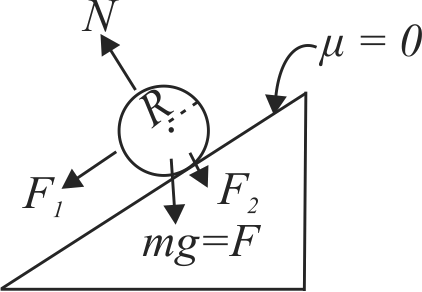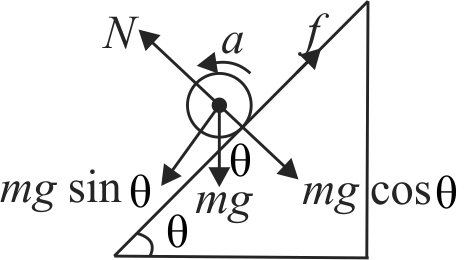366008
Assertion :
The velocity of a body at the bottom of an inclined plane of given height is more when it slides down the plane, compared to when it rolling down the same plane.
Reason :
In rolling down, a body acquires both, kinetic energy of translation and rotation.
366010 Three bodies a ring \((R)\), a solid cylinder \((C)\) and a solid sphere\((S)\) having same mass and same radius roll down the inclined plane without slipping. They start from rest, if \({v_R},{v_C}\) and \({v_S}\) are velocities of respective bodies on reaching the bottom of the plane, then
366008
Assertion :
The velocity of a body at the bottom of an inclined plane of given height is more when it slides down the plane, compared to when it rolling down the same plane.
Reason :
In rolling down, a body acquires both, kinetic energy of translation and rotation.
366010 Three bodies a ring \((R)\), a solid cylinder \((C)\) and a solid sphere\((S)\) having same mass and same radius roll down the inclined plane without slipping. They start from rest, if \({v_R},{v_C}\) and \({v_S}\) are velocities of respective bodies on reaching the bottom of the plane, then
366008
Assertion :
The velocity of a body at the bottom of an inclined plane of given height is more when it slides down the plane, compared to when it rolling down the same plane.
Reason :
In rolling down, a body acquires both, kinetic energy of translation and rotation.
366010 Three bodies a ring \((R)\), a solid cylinder \((C)\) and a solid sphere\((S)\) having same mass and same radius roll down the inclined plane without slipping. They start from rest, if \({v_R},{v_C}\) and \({v_S}\) are velocities of respective bodies on reaching the bottom of the plane, then
366008
Assertion :
The velocity of a body at the bottom of an inclined plane of given height is more when it slides down the plane, compared to when it rolling down the same plane.
Reason :
In rolling down, a body acquires both, kinetic energy of translation and rotation.
366010 Three bodies a ring \((R)\), a solid cylinder \((C)\) and a solid sphere\((S)\) having same mass and same radius roll down the inclined plane without slipping. They start from rest, if \({v_R},{v_C}\) and \({v_S}\) are velocities of respective bodies on reaching the bottom of the plane, then


